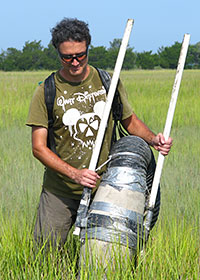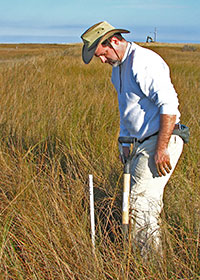Pennings and Więski Study Salt Marsh Cordgrass in Georgia

Kazik Więski sampling in the Georgia salt marshes.The health of salt marshes on the Georgia coast depends on the amount of water flowing
through the state’s rivers, according to a new study from the Georgia Coastal Ecosystems
Long-Term Ecological Research (GCE-LTER) Program.
For 12 years, University of Houston faculty, postdocs and students have traveled to Georgia to study salt marshes as part of the GCE-LTER program. The findings, published recently in the journal Ecosystems, were authored by Kazik Więski, a postdoc, and Steven Pennings, a professor in the UH Department of Biology and Biochemistry.
Salt marshes on the Georgia coast support fisheries and wildlife, filter nutrients, and protect the coast from storms. Many of these benefits come from vigorous growth of salt marsh cordgrass, Spartina alterniflora, a tall grass that is the most abundant plant in salt marshes. But growth of this plant can be as much as three times greater in one year than another.
To understand why, GCE-LTER scientists, operating out of the University of Georgia Marine Institute on Sapelo Island, measured the cordgrass growth in nine different marshes on the Georgia coast for 12 years. Pennings, who is the co-principal investigator on the grant, has been part of the team since measurements began in 2000.
“The single factor that best explained plant growth was the amount of water reaching the coast from the Altamaha River during the late spring and summer months,” Pennings said.

Steven Pennings conducting an experiment in Georgia.In years with more water flowing out of the river, plants were up to three times larger
than in years with little water flowing through the river. More fresh water reaching
the coast reduces the amount of salt in the marshes, which in turn reduces stress
that limits plant growth.
“Coastal rainfall and year-to-year variation in sea level also affected plant growth to some extent,” said Więski, the lead author on the paper explaining the discovery. “This was because rainfall and sea level also both affect the amount of salt in the marshes. But river flow had the greatest effect.”
“We tend to think of salt marsh plants as being adapted to high salt levels” said Pennings. “But tolerating high salt levels is still hard work for these plants. When they get a break from high salt levels, they have more resources that they can put into growth.”
Although some of the study sites were located very close to the Altamaha River, others were located as much as 15 miles away, yet river flow affected plant growth at all sites. This happened because the fresh river water that reaches the estuary rapidly spreads out and moves up and down the Georgia coast through the complex network of channels and intertidal marsh.
In addition, fresh water that reaches the ocean can be pushed back into adjacent estuaries by the wind and tides, explained Daniela Di Iorio, an associate professor of marine sciences at the University of Georgia who is also part of the GCE-LTER program.
“These results have implications for water management in the state of Georgia” said Merryl Alber, professor of marine sciences at the University of Georgia and the director of the GCE-LTER program. “Taking water out of Georgia rivers during the late spring and summer months, especially during dry years, could have a negative effect on the health of our coastal marshes.”
“We also found that hotter summers had less cordgrass growth,” said Więski said. “This happens because too much heat is also a stress to the plants. This is a potential concern for the future as we face rising global temperatures. But the implications for water management are something that we can address right now.”
Pennings says the findings from Georgia marshes are helpful to researchers interested in Texas coastal marshes.
“Water flow to the coast is likely even more important in Texas than in Georgia, because the coast is dryer and the marshes saltier,” he said. “As in Georgia, we have a number of local industries (shrimp fishing, recreational fishing, eco-tourism) that depend on healthy marshes.”
The Georgia Coastal Ecosystems Long-Term Ecological Research program started in 2000. Funded by the National Science Foundation, it involves 30 faculty members from 10 participating universities. More information about the program can be found at http://gce-lter.marsci.uga.edu/.
- Modified from news release issued by the University of Georgia